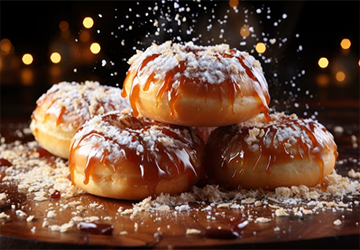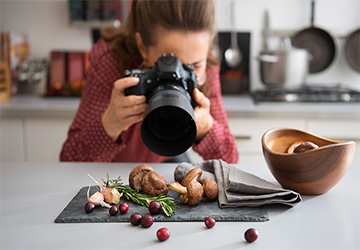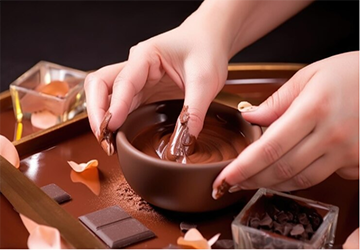Food photography has taken the world by storm, flooding our social media feeds with mouthwatering images that make us want to reach through the screen and take a bite. But how do they make it look so good?
It's not just about having a fancy camera – it's about knowing some clever tricks to turn an ordinary dish into a work of art. In this article, we'll spill the beans on the top 10 food photography tricks to help you capture stunning shots of your culinary creations.
1.Master the Art of Lighting
Understanding the concept of soft, diffused light is crucial when it comes to lighting. Soft light creates smooth shadows and minimizes harsh contrasts, making your food appear more inviting. Position your dish near a window but not in direct sunlight. Using sheer curtains or a white bedsheet can help diffuse light, making it gentler on your subject.
If you work indoors or shoot at night, consider investing in affordable LED lights or softboxes. These tools can provide consistent, even lighting. Place the light source at an angle to create soft shadows that add depth to your composition.

2.Find the Perfect Angle
Each dish has its best side, so feel free to experiment with angles until you find the one that showcases your creation beautifully. Overhead shots are ideal for capturing the intricate details of a flat dish, like a colorful salad.
The 45-degree angle adds depth and dimension, making dishes with multiple layers or textures like lasagna appear more enticing. Straight-on shots work well for symmetrical plates or those with an appealing front, like a stack of pancakes dripping with syrup.
3.Play with Props and Backgrounds
Props and backgrounds play a significant role in setting the mood of your food photos. Think about the story you want to tell. A rustic wooden experience can give a cozy, homey feel, while a sleek, marble surface lends an elegant touch. Layer your composition with vintage silverware, textured fabrics, or fresh ingredients that complement the dish's theme.
When choosing props, opt for pieces that aren't overly distracting and that harmonize with the colors and style of your dish. Remember, less is often more in food photography – simplicity can make your food shine.
4.Get Up Close and Personal
Zooming in and filling the frame with your dish allows viewers to appreciate the intricate details and textures. When photographing a juicy burger, move in close to capture the glistening droplets of condiments and the perfectly toasted bun. This technique makes viewers feel like they can almost taste the flavors and textures, drawing them into the delicious world you've created.
Close-up shots are especially effective for showcasing the intricate details of desserts, such as the layers of a cake or the swirls of frosting on a cupcake. They invite your audience to savor every element of your culinary masterpiece.
5.The Magic of Garnishes
Garnishes aren't just for show; they can add depth, contrast, and a touch of freshness to your food photography. Fresh herbs, such as basil leaves or parsley sprigs, provide a burst of color and an aromatic element. A sprinkle of powdered sugar can add sweetness, while a sauce drizzle adds movement and intrigue.
6.Timing is Everything
Timing plays a crucial role in capturing the essence of your food. When photographing dishes that change in appearance as they cool or sit, such as a melting scoop of ice cream or a sizzling steak, work quickly. Be prepared with your camera settings and composition in mind before you start shooting. This way, you can capture the dish's peak freshness and appeal.

7.Don't Forget About Composition
Composition is arranging elements within your frame to create a visually pleasing image. While the rule of thirds is helpful, feel free to experiment with other composition techniques. Consider using leading lines, framing, and negative space to enhance your food photography.
Leading lines can guide the viewer's eye toward the focal point, while framing elements, such as overhanging branches or the edge of a plate, can add depth and context.
8.Experiment with Depth of Field
Depth of field is a powerful tool in food photography. It allows you to control what's in focus and what's blurred in the background. A shallow depth of field, achieved with a wide aperture (low f-stop), can create a dreamy effect by blurring the ground while keeping the food sharp and detailed in the foreground. This technique works well for isolating the main subject and creating a sense of intimacy.
On the other hand, a deep depth of field, achieved with a smaller aperture (higher f-stop), is valuable when you want to capture more of the scene in focus. This can be advantageous for showcasing multiple dishes on a table or capturing a detailed table setting alongside your food.
9.Keep it Real
Authenticity is paramount in food photography. While some food stylists use tricks like motor oil for shine or food substitutes for visual appeal, it's best to use natural, fresh ingredients. Authenticity not only builds trust with your audience but also captures the true essence of the dish. So, embrace imperfections and quirks in your food.
10.Edit Wisely
Editing is the final step in enhancing your food photos. While going overboard with filters and effects can be tempting, remember that subtlety is often more effective. Start with basic adjustments like brightness, contrast, saturation, and white balance to fine-tune the overall look of your image.
Cropping is another essential editing tool. It allows you to refine the composition and remove any distracting elements from the frame. When cropping, remember the composition principles you've learned, such as the rule of thirds and the use of negative space.
Conclusion
Food photography is a delightful blend of creativity, technique, and patience. By mastering these top 10 food photography tricks, you'll be well on your way to capturing stunning shots that make your culinary creations look as irresistible as they taste. So, grab your camera, experiment, and most importantly, have fun – because passion is the secret ingredient to success when it comes to food photography.
















